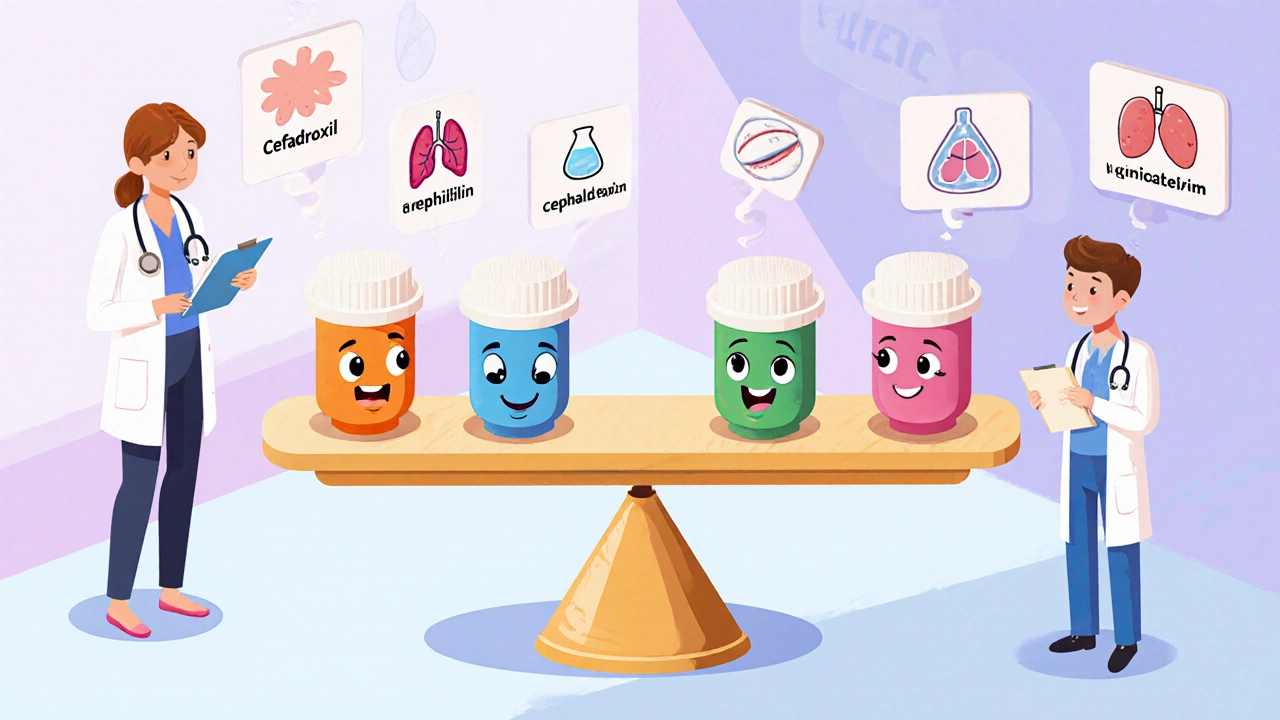When your doctor prescribes Cefadroxil, you might wonder if there’s a better or cheaper option. Maybe you’ve had side effects before. Or maybe you’re just trying to understand why this antibiotic was picked over others. You’re not alone. Many people ask the same thing: Cefadroxil vs. the rest. Let’s cut through the noise and compare it to the most common alternatives - with real-world context, not just textbook definitions.
What is Cefadroxil, really?
Cefadroxil is a first-generation cephalosporin antibiotic. That means it’s part of the same family as cephalexin (Keflex), but it’s not the same drug. It’s taken by mouth, usually once or twice a day, and it’s used for skin infections, urinary tract infections (UTIs), and some throat infections caused by bacteria like strep. It’s not for viral infections - no colds, no flu, no COVID. It works by breaking down the bacterial cell wall, which stops the infection from spreading.
Most people tolerate it well. Common side effects? Upset stomach, diarrhea, or a mild rash. Serious reactions - like allergic responses - are rare but possible, especially if you’re allergic to penicillin. About 10% of people with penicillin allergies also react to cephalosporins like Cefadroxil. That’s why your doctor asks about your allergy history before prescribing it.
Amoxicillin: The go-to alternative
If you’ve ever been prescribed an antibiotic for a sore throat or ear infection, chances are it was amoxicillin. It’s a penicillin-type drug, not a cephalosporin, but it’s often used for the same infections as Cefadroxil. So how do they stack up?
Amoxicillin has a broader range of activity. It works well against more types of bacteria, including some that Cefadroxil doesn’t touch. For example, amoxicillin is better for respiratory infections like sinusitis or bronchitis caused by certain strains of H. influenzae. Cefadroxil? It’s weaker there.
But Cefadroxil lasts longer in your body. You take it once or twice a day. Amoxicillin? Usually three times a day. That’s a big deal if you’re juggling work, kids, or a busy schedule. Missing doses lowers effectiveness and can lead to resistant bacteria.
Both can cause diarrhea. But amoxicillin is more likely to cause yeast infections in women - it wipes out the good bacteria in your gut and vagina. Cefadroxil? Less so. If you’ve had recurrent yeast infections after antibiotics, Cefadroxil might be the gentler pick.
Cephalexin: The close cousin
Cephalexin (Keflex) is almost identical to Cefadroxil. Same class. Same mechanism. Same side effects. So why do doctors choose one over the other?
It comes down to dosing and availability. Cephalexin is usually taken four times a day. Cefadroxil? Once or twice. That’s a major advantage for adherence. A 2023 study in the British Journal of General Practice found patients on once-daily antibiotics were 30% more likely to finish their full course than those on multiple-dose regimens.
Also, Cefadroxil is often cheaper in the UK. The NHS prescribes it more often for UTIs because of its cost-effectiveness. Cephalexin is still widely used - especially in the US - but in the UK, Cefadroxil has edged ahead for routine skin and urinary infections.
One small difference: Cefadroxil is slightly better absorbed when taken with food. Cephalexin? Doesn’t matter. If you forget to take it on an empty stomach, Cefadroxil still works.

Clindamycin: For penicillin allergies
If you’re allergic to penicillin and cephalosporins, your options shrink. That’s where clindamycin comes in. It’s not a beta-lactam antibiotic like Cefadroxil or amoxicillin. It’s from a different family and often used for skin abscesses, dental infections, or MRSA.
But here’s the catch: clindamycin has a higher risk of causing C. diff - a severe, sometimes life-threatening diarrhea. It’s rare, but when it happens, you end up in the hospital. Cefadroxil? Very low risk of C. diff.
Clindamycin is also not first-line for UTIs. It doesn’t concentrate well in urine. So if your infection is in your bladder, Cefadroxil is still the better choice - unless you’re allergic to everything in its class.
Trimethoprim: The UTI specialist
For simple urinary tract infections, many GPs in the UK skip antibiotics like Cefadroxil entirely and go straight for trimethoprim. It’s cheap, effective, and taken twice a day. It’s especially good for E. coli - the most common cause of UTIs.
But trimethoprim isn’t great for skin infections. It’s narrow in scope. Cefadroxil? It covers both skin and urinary bugs. So if you have a wound infection and a UTI at the same time, Cefadroxil can handle both. Trimethoprim can’t.
Also, trimethoprim can interact with other meds - like blood thinners or diabetes drugs. Cefadroxil? Fewer interactions. That makes it safer for older adults or those on multiple prescriptions.
When not to use Cefadroxil
Cefadroxil isn’t magic. It won’t work for:
- Strep throat if you’re allergic to penicillin (use azithromycin instead)
- Severe pneumonia or hospital-acquired infections (you’ll need stronger IV antibiotics)
- Bacterial resistance - if you’ve taken Cefadroxil before and it didn’t work, it’s probably useless now
- Viruses - no colds, flu, or most sore throats
Also, avoid it if you have kidney problems. Your doctor will need to lower the dose. Cefadroxil is cleared by the kidneys, so if they’re not working well, the drug builds up and can cause side effects.

Real-world choice: What does your doctor pick?
In the UK, NHS guidelines (NICE) recommend Cefadroxil as a first-line option for uncomplicated UTIs in adults who can’t take trimethoprim or nitrofurantoin. For skin infections like cellulitis, it’s a solid second choice after flucloxacillin - unless you’re allergic.
Doctors in Bristol, Manchester, or Glasgow aren’t choosing based on brand names. They’re picking based on:
- What bacteria are likely causing the infection
- Your allergy history
- How often you’ll take it
- Cost and availability
- Your kidney function
For a healthy adult with a simple UTI: trimethoprim first. If that’s not possible, Cefadroxil.
For a child with impetigo: Cefadroxil or cephalexin - both work, but Cefadroxil’s once-daily dosing makes it easier for parents.
For someone with a penicillin allergy: clindamycin or azithromycin - but only if the infection type fits.
What about generics and cost?
Cefadroxil is available as a generic in the UK. A 10-day course costs around £5-£8 through the NHS. Amoxicillin? Also generic, around £3-£6. But you need to take it three times a day. Cephalexin? Similar price, but you take it four times a day. When you factor in adherence and effectiveness, Cefadroxil often ends up being the most cost-effective choice.
Brand names like Duricef (Cefadroxil) cost more - but you don’t need them. Generics are just as safe and effective. Always ask for the generic unless your doctor says otherwise.
Bottom line: Which one should you take?
There’s no single "best" antibiotic. It depends on your infection, your body, and your history.
Choose Cefadroxil if:
- You have a skin or urinary infection
- You can’t take trimethoprim or nitrofurantoin
- You need a once- or twice-daily dose
- You’re not allergic to penicillin
- You want a low risk of yeast infections or C. diff
Choose amoxicillin if:
- You have a respiratory infection
- You don’t mind taking it three times a day
- You have no penicillin allergy
Choose cephalexin if:
- Cefadroxil isn’t available
- You’re in a country where it’s more common
Choose clindamycin or azithromycin only if you’re allergic to beta-lactams - and even then, only if the infection type matches.
Never self-prescribe. Never finish an antibiotic early just because you feel better. And never share your meds. Antibiotics are like keys - they only unlock specific infections. Use the wrong one, and you risk resistance, relapse, or worse.
Is Cefadroxil stronger than amoxicillin?
Not necessarily. Cefadroxil and amoxicillin work against different types of bacteria. Amoxicillin covers more respiratory bugs, while Cefadroxil is better for skin and urinary infections. Strength depends on the infection, not the drug name.
Can I take Cefadroxil if I’m allergic to penicillin?
About 10% of people with penicillin allergies also react to Cefadroxil. It’s not guaranteed, but the risk is real. If you’ve had a serious reaction to penicillin - like swelling, trouble breathing, or anaphylaxis - avoid Cefadroxil. For mild rashes, your doctor might still prescribe it after testing.
Why is Cefadroxil taken less often than cephalexin?
Cefadroxil is taken once or twice a day. Cephalexin is taken four times a day. Fewer doses mean better adherence. In the UK, NHS guidelines favor Cefadroxil for this reason. In the US, cephalexin is more common because it’s been around longer and is widely stocked.
Does Cefadroxil cause yeast infections?
Less often than amoxicillin. Cefadroxil disrupts gut bacteria less aggressively, which lowers the chance of yeast overgrowth. But it’s still possible - especially with longer courses. If you get itching or discharge, talk to your doctor. Antifungal treatments are available.
Is Cefadroxil safe for children?
Yes. It’s commonly prescribed for children with skin infections like impetigo or strep throat. Dosing is based on weight. Always follow your doctor’s instructions - never guess the dose. Side effects in kids are usually mild: diarrhea or upset stomach.
Can I drink alcohol while taking Cefadroxil?
Yes. Unlike some antibiotics (like metronidazole), Cefadroxil doesn’t interact with alcohol. But drinking can worsen side effects like nausea or dizziness. If you’re feeling unwell, it’s better to skip it until you’re back on your feet.
